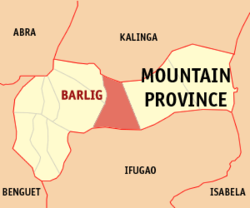Barlig
Barlig
Fialikia/Likaw-an | |
|---|---|
 Panoramic photo of Barlig and surrounding rice terraces | |
 Map of Mountain Province showing the location of Barlig | |
| Country | Philippines |
| Region | Cordillera Administrative Region (CAR) |
| Province | Mountain Province |
| District | Lone District |
| Barangays | 11 |
| Government | |
| • Mayor | Clark Chatongna Ngaya |
| Area | |
| • Total | 228.64 km2 (88.28 sq mi) |
| Population (2010)[3] | |
| • Total | 5,838 |
| • Density | 26/km2 (66/sq mi) |
| Time zone | UTC+8 (PST) |
| ZIP code | 2623 |
| Dialing code | 74 |
| Income class | 5th class |
Barlig is a fifth class municipality in the province of Mountain Province, Philippines. According to the 2010 census, it has a population of 5,838 people.[3]
Barlig is bounded in the east by Natonin in the west by Bontoc and Sadanga. In the north, it is bounded by Tinglayan and in the south by the town of Mayoyao. The town is separated into three settlements or cluster of villages such as Barlig town proper, Lias and Kadaclan.[4]
Barangays
Barlig is politically subdivided into 11 barangays.[2]
- Chupac
- Fiangtin
- Kaleo
- Latang
- Lias Kanluran
- Lias Silangan
- Lingoy
- Lunas
- Macalana
- Ogoog
- Gawana (Poblacion)
Climate
Barlig has an oceanic climate (Köppen climate classification Cfb) closely bordering a subtropical highland climate ("Cwb") with relatively dry winters.
| Climate data for Barlig, Mountain Province | |||||||||||||
|---|---|---|---|---|---|---|---|---|---|---|---|---|---|
| Month | Jan | Feb | Mar | Apr | May | Jun | Jul | Aug | Sep | Oct | Nov | Dec | Year |
| Mean daily maximum °C (°F) | 21.3 (70.3) |
22.5 (72.5) |
23.5 (74.3) |
24.3 (75.7) |
24.4 (75.9) |
23.4 (74.1) |
22.5 (72.5) |
22.0 (71.6) |
22.5 (72.5) |
22.9 (73.2) |
22.3 (72.1) |
21.7 (71.1) |
22.8 (73.0) |
| Daily mean °C (°F) | 16.8 (62.2) |
17.6 (63.7) |
18.8 (65.8) |
19.8 (67.6) |
20.3 (68.5) |
19.8 (67.6) |
19.2 (66.6) |
18.8 (65.8) |
19.1 (66.4) |
19.1 (66.4) |
18.3 (64.9) |
17.6 (63.7) |
18.8 (65.8) |
| Mean daily minimum °C (°F) | 12.4 (54.3) |
12.7 (54.9) |
14.1 (57.4) |
15.3 (59.5) |
16.2 (61.2) |
16.2 (61.2) |
15.9 (60.6) |
15.7 (60.3) |
15.7 (60.3) |
15.4 (59.7) |
14.4 (57.9) |
13.6 (56.5) |
14.8 (58.6) |
| Average rainfall mm (inches) | 98 (3.9) |
54 (2.1) |
98 (3.9) |
162 (6.4) |
316 (12.4) |
350 (13.8) |
437 (17.2) |
489 (19.3) |
380 (15.0) |
330 (13.0) |
368 (14.5) |
184 (7.2) |
3,266 (128.6) |
| [citation needed] | |||||||||||||
Demographics
| Year | Pop. | ±% p.a. |
|---|---|---|
| 1990 | 6,273 | — |
| 1995 | 7,477 | +3.34% |
| 2000 | 6,351 | −3.44% |
| 2007 | 6,168 | −0.40% |
| 2010 | 5,838 | −1.98% |
| Source: National Statistics Office[3] | ||
The people of Barlig are dominantly of Igorot descent. Locals call themselves Ifiallig which is a reference to someone born or have roots from villages. In the cluster of villages in Lias, people call themselves I-lias while those from Kadaclan villages call themselves Ekachakran. Despite living in a single town, the people speak different languages and probably traditions.[4]
Tourism
Barlig town boasts of its own rice terraces, the Barlig Rice Terraces in the near the center of the town and Lias Rice Terraces in the Lias, which is a cluster of villages. In Kadaclan, which is another cluster of villages, the annual Menaliyam festival is held.
References
- ^ "Official City/Municipal 2013 Election Results". Intramuros, Manila, Philippines: Commission on Elections (COMELEC). 11 September 2013. Retrieved 23 December 2013.
- ^ a b "Province: Mountain Province". PSGC Interactive. Makati City, Philippines: National Statistical Coordination Board. Retrieved 23 December 2013.
- ^ a b c "Total Population by Province, City, Municipality and Barangay: as of May 1, 2010" (PDF). 2010 Census of Population and Housing. National Statistics Office. Retrieved 23 December 2013.
- ^ a b http://barlig.wordpress.com/about
- ^ "Climate data for: Barlig". Retrieved 2015-11-15.

